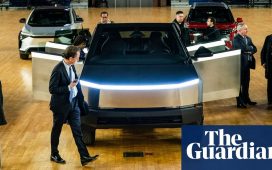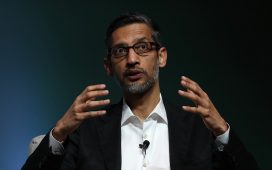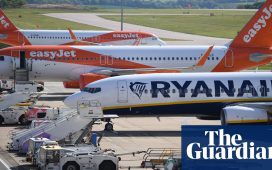GRÜNHEIDE, Germany — The vast pale gray factory with its own exit on the autobahn, surrounded by a pine forest east of Berlin, was supposed to be producing shiny new Teslas by now. Instead it has become a manifestation of what happens when Silicon Valley ambition collides with German procedure.
The $7 billion factory, which will supply the fast-growing European market for electric cars, is at least six months behind schedule, according to local officials. And Tesla may be even further away from producing cars in Germany because construction has only just begun on an adjacent factory that will supply batteries. Tesla declined to comment.
Tesla’s first major assembly plant in Europe has strong support from regional political leaders, but it has been held up by legal challenges from environmental groups, delays in the approval process by regional and national agencies, and the carmaker’s own revisions to the plan. Tesla must also find new homes for the site’s current residents: a species of lizard, and the kind of snake that likes to eat it.
The slipping start date could prove costly to Tesla. It buys time for competing manufacturers like Volkswagen, Mercedes-Benz and Renault to try to establish their own expanding lineups of electric cars.
Tesla’s Model 3, which the company imports to Europe from China or the United States, is the top-selling electric vehicle on the continent. But Volkswagen’s electric models, like the ID.3 hatchback and ID.4 sport utility vehicle, introduced during the last year, have surpassed Tesla in combined sales, according to Matthias Schmidt, an independent analyst in Berlin who tracks electric car sales in Europe.
“The European market is completely hot at the moment,” Mr. Schmidt said. “Definitely it’s an opportunity missed for Tesla and an opportunity gained for European manufacturers.”
The history of American carmakers that have jumped the Atlantic and found a profitable home in Europe is a thin one. Dealing with troublesome labor unions and difficulties reading the preferences of local car buyers have made Europe a money pit for foreign carmakers.
General Motors in 2017 sold its European Opel and Vauxhall operations to the company now known as Stellantis after decades of losses. Ford of Europe has struggled to arrest a decline in market share, which was a meager 4 percent in May in the European Union. Even Toyota, with 6 percent of the European market, has been unable to match the popularity it enjoys in Asia and the United States.
Elon Musk, Tesla’s chief executive, appears to have chosen Germany for the company’s third major assembly plant, which will be able to produce an estimated 500,000 vehicles a year, in part because he wanted to tap the expertise in engineering and manufacturing that has allowed Mercedes-Benz, Audi and BMW to dominate the global market for luxury passenger cars. Last year, he dressed up in a black vest, white shirt and wide-brimmed hat, the traditional dress of a German journeyman builder, for a celebration marking the completion of the factory’s girder structure.
The get-up masked a more fundamental clash of cultures at work.
“On the one hand you have the American enthusiasm for new ideas, for implementing them as quickly as possible,” said Rolf Lindemann, county commissioner of Oder-Spree, the site of the factory. “On the other side you have that German approach, to think things through all the way to their conclusion, see the consequences and to try to minimize risks — to analyze the whole thing deeply.”
The delay is nothing new for Tesla, which has a long history of overly optimistic timelines for autonomous driving, electric long-haul trucks and rocket launches.
But Mr. Musk may have gotten more German culture than he bargained for. Germany is a country of implacable environmental activists like Manuela Hoyer, a 61-year-old former union organizer who lives about six miles from the factory and is one of the few people who believe it can still be stopped before it produces its first car. That may be unrealistic, considering that the factory appears to be close to completion, with workers putting the finishing touches on the exterior and installing machinery inside.
“When the second-richest man in the world shows up, they roll out the red carpet and give him everything he asks for,” said Ms. Hoyer, who has been charged with trespassing on the site. (The charges were dropped.) “That really is a crime, not just against the environment but also against the population here.”
Ms. Hoyer, who is part of a small citizens’ group that keeps an eye on the Tesla project, speaks up at public hearings on the project, and is a fierce letter writer who sends missives to local officials or calls the police whenever she sees something at the site that she considers an infringement of local clean water laws or other ordinances.
Two other groups, the Nature Protection Federation of Brandenburg, known as NABU, and the Green League, have gone to court to force Tesla to relocate a population of sand lizards, roughly 10 inches in length and bright green and gray, that thrive in the site’s sandy soil, as well as several 30-inch-long smooth adders. Both species are considered threatened under German and European law.
Complicating the operation, which is supposed to be completed by the end of the summer, the snakes prey on the lizards. The environmentalists say the lizards must be moved first so they can adjust to the new habitat and stand a fighting chance to survive once their predators arrive.
The environmental groups trying to sue Tesla say they do not expect to be able to stop the project. But they want to prevent Tesla from cutting corners, and they have so far succeeded in reducing the number of trees the company was allowed to cut down.
“Not everything can be done at Tesla speed,” said Christiane Schröder, the regional head of NABU.
Tesla has not yet had to deal in earnest with Germany’s tough labor unions and laws that favor them. Birgit Dietze, the leader of the regional unit of the IG Metall union, which represents German autoworkers, said by email that it “depends on the employees” how much they ultimately wanted to organize. “If they want to organize for good working conditions and push for a wage contract, we will support them.”
Political leaders in the region are staunchly on Tesla’s side. They point to the more than 10,000 jobs that Tesla is expected to create, as well as thousands of additional jobs at suppliers, nearby retailers and other local businesses.
Jörg Steinbach, the minister in charge of economic affairs for the State of Brandenburg, helped persuade Tesla to build the factory in Grünheide and has staked his political future on the project’s success. Of the project’s opponents, he said, “The noise that they make is out of proportion to their numbers.”
But Mr. Steinbach also expressed some frustration with Tesla’s apparent indifference to local public opinion, grumbling that he often has to act as Tesla’s mouthpiece because the company makes little effort to communicate with the local community.
“I’ve said it more than once: I’m not the press spokesman for Tesla,” Mr. Steinbach said.
Some of the delays have been caused by Tesla, which has revised its building permit application at least 15 times, officials said, prompting the need for new temporary approvals.
Whenever it opens, the assembly plant is already a massive structure. An aerial tour by local drone operators shows a finished roof with rows of skylights and mushroom-shaped ventilation pipes. At ground level, loading bays stand ready to receive components and raw materials.
Arne Christiani, the mayor of Grünheide, sees the factory as a chance to revive an area that was once part of East Germany and that has suffered since the reunification of Germany in 1990, when young people migrated west in search of more excitement and opportunity.
Before the fall of the Berlin Wall, one of the biggest employers in the area was a facility where the Stasi secret police steamed open and read mail that East Germans received from friends and family in the West. The site where the Tesla factory stands was used by East German soldiers preparing to fight NATO; in fact, the property was cleared of unexploded munitions before construction could begin.
Mr. Christiani dismisses opponents of the site as a small but vocal minority dominated by affluent newcomers — an accusation Ms. Hoyer rejects. The mayor expresses hope that the factory will get even bigger, and draw other businesses to the region.
“There are opportunities we never would have talked about two years ago,” Mr. Christiani said.





